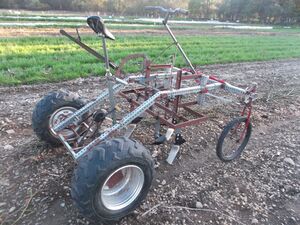Tractors: Difference between revisions
From
No edit summary |
No edit summary |
||
| Line 7: | Line 7: | ||
|transformations = | |transformations = | ||
|lifecycles = | |lifecycles = | ||
|tools = [[Wrenches]] | |tools = [[Wrenches]], [[Cutters]] | ||
|parts = [[Frames]], [[Nuts]], [[Bolts]], [[End caps]], [[Casters]], [[Batteries]], [[Controllers]], [[Wheels]], [[Wheel hubs]], [[Tires]], [[Keyed shafts]], [[Keys]], Optional: [[Hydraulic valves]], [[Hydraulic hoses]], [[Hydraulic valves]], [[Hydraulic power units]], [[Hydraulic pistons]], [[Hydraulic motors]], [[Hydraulic couplers]] | |parts = [[Frames]], [[Nuts]], [[Bolts]], [[End caps]], [[Casters]], [[Batteries]], [[Controllers]], [[Wheels]], [[Wheel hubs]], [[Tires]], [[Keyed shafts]], [[Keys]], Optional: [[Hydraulic valves]], [[Hydraulic hoses]], [[Hydraulic valves]], [[Hydraulic power units]], [[Hydraulic pistons]], [[Hydraulic motors]], [[Hydraulic couplers]] | ||
|techniques = [[Tri joints]], [[Three point hitches]] | |techniques = [[Tri joints]], [[Three point hitches]] | ||
Revision as of 07:03, 26 April 2023
Project: Tractors
| Tools: | Wrenches, Cutters |
|---|---|
| Parts: | Frames, Nuts, Bolts, End caps, Casters, Batteries, Controllers, Wheels, Wheel hubs, Tires, Keyed shafts, Keys, Optional: Hydraulic valves, Hydraulic hoses, Hydraulic valves, Hydraulic power units, Hydraulic pistons, Hydraulic motors, Hydraulic couplers |
| Techniques: | Tri joints, Three point hitches |
Introduction
A tractor is an engineering vehicle specifically designed to deliver a high tractive effort (or torque) at slow speeds, for the purposes of hauling a trailer or machinery such as that used in agriculture, mining or construction. Most commonly, the term is used to describe a farm vehicle that provides the power and traction to mechanize agricultural tasks, especially (and originally) tillage, but nowadays a great variety of tasks. Agricultural implements may be towed behind or mounted on the tractor, and the tractor may also provide a source of power if the implement is mechanised.
Challenges
Approaches
Light duty electric
- MRV050 or NMRV050 worm gear reducer
- MRV050 Worm Gear Speed Reducer 1" Keyed Single Output Shaft Kit
- PROGRESSIVE AUTOMATIONS 12V High Force (3000 lbs) Linear Electric Actuator PA-13
- PROGRESSIVE AUTOMATIONS Industrial Linear Actuator Stroke Size 12", Force 2000 lbs PA-17
- Gearbox mounting plate x 2
- Linear actuator mounting plate x 4 per actuator
- Arm pivot plate x 4 (can include linear actuator mounts)
- Hoist Crane Remote Control Wireless F24-60 12V
Optional tracks
- Bobcat MT52 tracks
- MT52 drive sprocket
- MT52 front idler with adjustment
- MT52 rear idler
- MT52 bottom roller
Medium duty electric hydraulic
Medium duty gas hydraulic
References
- http://opensourceecology.org/wiki/LifeTrac
- OpenSourceEcology LifeTrac 1
- OpenSourceEcology: LifeTrac 2 Build
- OpenSourceEcology: Bulldozer
- OpenSourceEcology: LifeTrac 6
- http://sniejik.com/
- https://www.niekampinc.com/electric-g-tractor/
- https://thinkoggun.com/
- Soletrac electric tractor
- Monarch tractor
- OpenSourceEcology: Universal Track Unit
- Wikipedia: Tractor
- OpenSourceEcology: Tractor Construction Set 2017
- OpenSourceEcology: Cory Shenk's log
- Science.org: Big Tractors Now Heavier Than Dinosaurs, Can Cause Deep Soil Damage
- Hand-E Tractor
- https://www.tilmor.com/en-us/products/33/tilmor-tractor?sc=46-11105 Tilmor Tractor]
